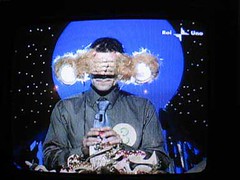Kiss your television
[ORIGINALLY POSTED ON ARTMOBILE, A DISCUSSION GROUP ON THE ARTS IN BALTIMORE]
This kind of remark
My TV manifesto would insist that folks reserve the right to use the box in a frivolous manner, for starters. Folks read all kinds of crap, in all kinds of situations--not that there's anything wrong with that. Reading well-crafted genre stuff is immensely pleasureable (though not virtuous). From Hugh Kenner,
I suppose part of the problem folks have with TV is the pleasure it brings; it's our old puritan heritage coming back to bite us once again. I find McLuhan instructive here, noting that television is a terribly inefficient way to learn, compared to a book. But it's a fantastic emotion box, economically capturing human interaction in a way that a book cannot [see: crying in front of the tube and the eternal allure of good reality television].
It's no mistake that sitcoms and soap operas and "reality" shows have persisted since the beginning of the artform--that was a great revelation of the Treasures from the American Film Archives series (available on DVD): these forms are well-neigh Platonic, they have always been with us and entertained us. They are profoundly human, and not to be feared.
This kind of remark
As someone who uses television in what I consider to be an intelligent manneris from what passes in this forum as a "reasonable" supporter of TV. One thing lost in most critical discussions of television is the pleasure that watching brings (yeah, I know--you are immune from its allure). Of course most of what's on TV doesn't appeal to you, but how many books on the bestseller lists do? How many films in the cineplex? That it is labor-intensive to sort what works does not suffice to dismiss the medium.
My TV manifesto would insist that folks reserve the right to use the box in a frivolous manner, for starters. Folks read all kinds of crap, in all kinds of situations--not that there's anything wrong with that. Reading well-crafted genre stuff is immensely pleasureable (though not virtuous). From Hugh Kenner,
We forget that most of what people read when everybody read all the time was junk — competent junk," he told U.S. News & World Report. "Now they get it from television. The casual entertainment people get in the evening from the box was what they used to get from the short fiction in The Saturday Evening Post. That magazine and others like it were the situation comedies and cop shows of their era. It is not a cultural loss that this particular use of literacy has been transferred from one medium to another.I assert that viewing the Lord of the Rings on DVD is a vastly more satisfying and rich experience than slogging through the books, which are little more than a martial account with little feel for the fables and themes that Peter Jackson conveys onscreen (and with none of the turgid prose and bad poetry).
I suppose part of the problem folks have with TV is the pleasure it brings; it's our old puritan heritage coming back to bite us once again. I find McLuhan instructive here, noting that television is a terribly inefficient way to learn, compared to a book. But it's a fantastic emotion box, economically capturing human interaction in a way that a book cannot [see: crying in front of the tube and the eternal allure of good reality television].
It's no mistake that sitcoms and soap operas and "reality" shows have persisted since the beginning of the artform--that was a great revelation of the Treasures from the American Film Archives series (available on DVD): these forms are well-neigh Platonic, they have always been with us and entertained us. They are profoundly human, and not to be feared.


































